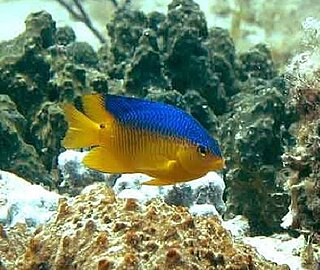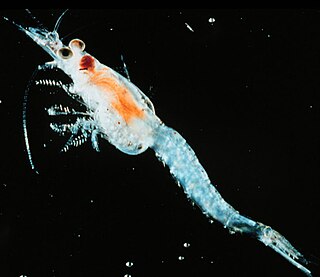
Damselfish are those within the subfamilies Abudefdufinae, Chrominae, Lepidozyginae, Pomacentrinae, and Stegastenae within the family Pomacentridae. Most species within this group are relatively small, with the largest species being about 30cm in length. Most damselfish species exist only in marine environments, but a few inhabit brackish or fresh water. These fish are found globally in tropical, subtropical, and temperate waters.

Mysida is an order of small, shrimp-like crustaceans in the malacostracan superorder Peracarida. Their common name opossum shrimps stems from the presence of a brood pouch or "marsupium" in females. The fact that the larvae are reared in this pouch and are not free-swimming characterises the order. The mysid's head bears a pair of stalked eyes and two pairs of antennae. The thorax consists of eight segments each bearing branching limbs, the whole concealed beneath a protective carapace and the abdomen has six segments and usually further small limbs.

Mysidae is the largest family of crustaceans in the order Mysida, with over 1000 species in around 170 genera.

Mysis is a genus of mysid crustaceans in the family Mysidae, distributed mainly in the coastal zone of the Arctic and high boreal seas. Several species also inhabit northern freshwater lakes and the brackish Caspian Sea. Fifteen species are recognized. Body lengths range from 1 to 3 centimetres.

Neomysis is a genus of opossum shrimp from the family Mysidae, distributed in the coastal zone of temperate seas of the Northern Hemisphere and South America. Several species, particularly from the West Pacific, are also found in fresh and brackish waters. The genus contains the following 18 species:

Praunus flexuosus, known as the chameleon shrimp, is a species of opossum shrimp found in European waters. It reaches 26 mm (1.0 in) long, with a distinctly bent body, and closely resembles Praunus neglectus. It lives in shallow water and tolerates a wide range of salinities. It is found from northern France to the Baltic Sea, and was introduced to North America in the mid 20th century.
Heteromysis actiniae, commonly known as the anemone mysid, is a species of opossum shrimp from the family Mysidae found in association with the sea anemone Bartholomea annulata. It is found in the Caribbean Sea and the Gulf of Mexico.

Idiomysis is a genus of small mysids found in warm, shallow waters of Indian Ocean and Pacific.

Heteromysis is a genus of marine mysid crustaceans from the family Mysidae, associated with various shallow-water invertebrates. The name describes differentiation of its pereiopods as possible adaptation to commensal life-style. Heteromysis is one of the largest mysid genera, containing more than 100 species. The genus is distributed globally, but predominantly in tropical and subtropical waters.
Victor Vladimirovich Petryashov was a Russian zoologist, carcinologist, hydrobiologist and biogeographer. His scientific research focused on taxonomy and distribution of malacostracan crustaceans, particularly orders Mysida, Lophogastrida and Leptostraca, and marine biogeography and hydrobiology of Arctic, Antarctic and temperate seas of the World, and he published over 120 works. V.V. Petryashov spent all his professional life in St. Petersburg in the Zoological Institute of the Russian Academy of Sciences. As a senior researcher he also curated the malacostracan crustacean collection of the Zoological Institute.
Paramysis intermedia is a species of shrimp in the family Mysidae. Its natural distribution is Ponto-Caspian, but it is also invasive species, e.g. on the Baltic coast of Estonia. It tolerates salinities between 0–12 ppt; it occurs in estuaries but does not penetrate very deep into rivers.
Anuropus is a genus of isopods in the suborder Cymothoida. As of 2021, it is the only genus in the family Anuropidae.
Neobirsteiniamysis is a mysid crustacean genus of the subfamily Boreomysinae of the family Mysidae. Some of the largest mysids. Exclusively deep water. Cosmopolitan. 2 species.
Neobirsteiniamysis inermis is a deepwater mysid crustacean species of the genus Neobirsteiniamysis. One of the largest and the only known mysid, distributed in both polar regions.
Boreomysinae is a subfamily of large, mostly deep-water oceanic mysid crustaceans from the family Mysidae. The name, which can be translated as "northern mysids", comes from the genus Boreomysis G.O. Sars, 1869, established for Boreomysis arctica from the boreal waters of Atlantic. As more species have been discovered subsequently, the subfamily is considered panoceanic, and includes 38 species from two genera, Boreomysis and Neobirsteiniamysis Hendrickx et Tchindonova, 2020.
Boreomysis is a mysid crustacean genus, the type of the subfamily Boreomysinae of the family Mysidae. Majority of the species are found in the ocean deep water. Cosmopolitan. 38 species.
Boreomysis inopinata is a species of mysid crustaceans from the subfamily Boreomysinae. It is also a member of the nominotypical subgenus Boreomysis sensu stricto. The species is a deepwater bathypelagic mysid, found only from the Tasman Sea off Australia.
Boreomysis sibogae is a species of mysid crustaceans from the subfamily Boreomysinae. It is also a member of the nominotypical subgenus Boreomysis sensu stricto. The species is an epi-bathypelagic mysid, widely distributed in the Indo-Pacific and possibly also in the Atlantic Ocean.
Boreomysis sphaerops is a species of mysid crustaceans from the subfamily Boreomysinae. It is also a member of the nominotypical subgenus Boreomysis sensu stricto. The species is a meso-bathypelagic mysid, distributed in the West Indo-Pacific, although known only from few records off Japan and Australia.
Boreomysis urospina is a species of mysid crustaceans from the subfamily Boreomysinae. It is also a member of the subgenus Petryashovia. The species is a mesopelagic mysid, found only in the Tasman Sea, off Australia.







